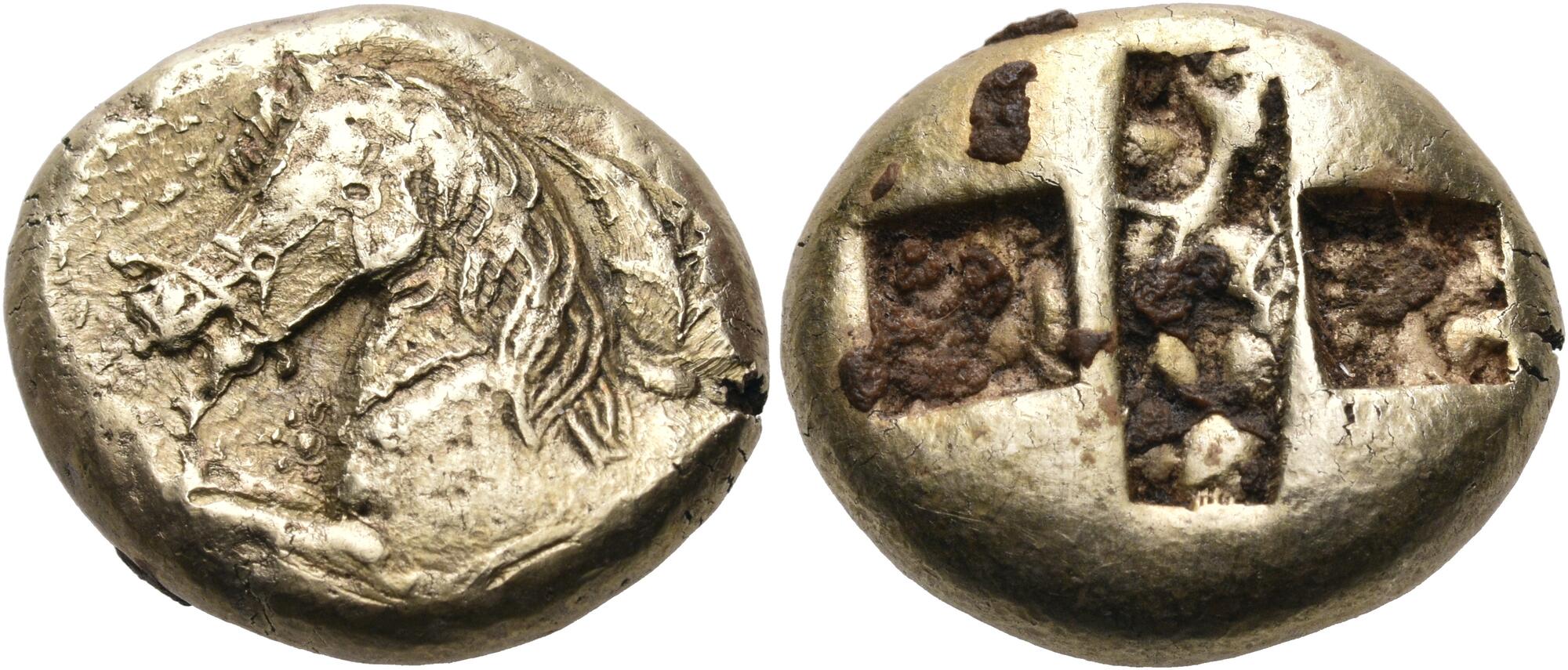S 1614 - Ionia (uncertain mint), electrum, staters (550-525 BCE)
From SILVER
550 BCE - 525 BCE Electrum 12,155 kg
Description
| ObverseInscription or printing placed on the obverse.: | Forepart of a bridled horse to left, rosette at the horse's breast and an uncertain floral symbol at the nape of the horse's neck, in the field to left, grape vine with clusters |
| ReverseInscription or printing placed on the reverse.: | Rectangular incuse flanked by two smaller incuse square, both types with irregular fillings |
Mint and issuing power
| MintIdentifies the place of manufacture or issue of a numismatic object.: | Ionia (uncertain mint) | Ancient regionAncient region.: | Ionia | Modern countryModern country: Turkey | AuthorityIdentifies the issuing power. The authority can be "pretended" when the name or the portrait of X is on the coin but he/she was not the issuing power. It can also be "uncertain" when there is no mention of X on the coin but he/she was the issuing power according to the historical sources: |
Chronology
| FromIdentifies the initial date in a range assigned in a numismatic context. | 550 BCE | toIdentifies the final date in a range assigned in a numismatic context.. | 525 BCE | PeriodTime period of the numismatic object.: Archaic until 480 BC |
Physical description
| MetalThe physical material (usually metal) from which an object is made.: | Electrum http://nomisma.org/id/el | Median weightMedian of the weights of numismatic objects (in grams). in grams | 14.20 | DenominationTerm indicating the value of a numismatic object. Examples: tetradrachm, chalkous, denarius.: | stater |
StandardStandard.: | Milesian |
Image

S1614 Ionia Staters.jpg [1]
References
| Die study referencePublication of the study: | Fischer-Bossert 2016d1Fischer-Bossert 2016d, p. 6-7, n° 1-4 | ||
| Coin series referenceReference to coin series study: | |||
Obverse dies distribution
| FrequencyFrequency of specimen in distribution. ᵖ | Number of obversesNumber of obverse dies. ᵖ (o) | % (o) | Number of coinsNumber of coins. (n) | % (n) | Die nameName(s) of the die(s). |
| 1 | 2 | 50 | 2 | 8 | 1, 3 |
| 4 | 1 | 25 | 4 | 16 | 4 |
| 19 | 1 | 25 | 19 | 76 | 2 |
| Total | 4 of 4 | 100 | 25 of 25 | 100 |
Reverse dies distribution
no distribution is available
Quantification
| Number of obversesNumber of obverse dies. ᵖ (o) | 4 | Number of singletons (o1)The number of singleton coins. ᵖ | 2 |
| Number of reverse diesNumber of reverse dies. (r) | Number of coinsNumber of coins. (n) | 25 | |
| Coins per obverse dieNumber of coins per obverse die. (n/o) | 6.25 | Coins per reverse dieNumber of coins per reverse die. (n/r) | |
| Reverse per obverse ratioRatio of obverse dies divided by reverse dies. (r/o) | Percentage of singletons (o1)number of coins (n) divided by the number of singletons (o1) ᵖ | 50 % | |
| Original number of dies (O) (Carter 1983 formula)The estimation of the number of coins according to Carter 1983 ᵖ | 4.28 | Coins struck if 20,000 as average productivity per dieCoins made if the average productivity for obverses (according to Carter) is 20,000. ᵖ | 85,600 |
| Original number of dies (O) (Esty 2011 formula)The estimation of the number of coins according to the singleton formula in Esty 2011 ᵖ (O) | 4.76 | Survival rate if 20,000 as average productivity per dieSurvival rate if average productivity is 20,000. ᵖ | 0.00029 |
| Coverage (o = % of O) (Esty 1984 formula)Esty 1984 - coverage (% of O) ᵖ (o = % of O) | 92% | Die productivity if survival rate 1/2,000Average productivity if survival rate is 1/2,000. ᵖ | 11,682.24 |
| Weight of silver (in kg) if 20,000 coins per die (O = Carter formula)Carter 1983 * Median weight * 20000 (*10 if gold or electrum) ᵖ | 12,155 kg <br /> 12,155 kg | Die productivity if survival rate 1/5,000Average productivity if survival rate is 1/5,000. ᵖ | 29,205.61 |
Remarks
References
- ^ Fischer-Bossert, Wolfgang (2016), "Horses with and without wings", in in Michele Asolati, Bruno Callegher and Andrea Saccocci (eds.), Suadente nummo vetere. Studi in in onore di Giovanni Gorini, Padova, p. 1-21